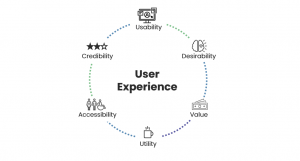While the user experience (UX) and accessibility form a crucial part of a user’s actual experience, the usability of a website or mobile application should always be a priority. Often used interchangeably; how are usability, UX and accessibility different from each other? And, how do they relate to each other?

What is usability and how is it different to user experience?
In the words of ISO 9241 usability is concerned with “the effectiveness, efficiency and satisfaction with which specified users achieve specified goals in a particular environment” In our case, these are digital services and systems. Usability forms a part of the user experience which is also dictated by the utility of the product, it’s desirability and the overall brand experience.
How is usability different from accessibility?
The principles and techniques behind usability and accessibility (often shortened to A11y) are very similar, but there are a few key differences between designing with usability versus accessibility in mind.
- Usability is focused on ‘typical’ users and environments
- Usability works on design principles rather than universal standards
Making products usable for people who have disabilities almost always benefits people who do not have disabilities. Accessibility can be considered a branch of usability that focuses on user groups with very specific needs; however, if your product is designed primarily to be used by those with disabilities then usability and accessibility become one.
79 percent of users feel the overall usability of an application is the most important aspect. So, how do you evaluate how usable your product is?
There are many different methods of reviewing and testing the usability and user experience of a product. Testing can be formative and used to generate ideas and inform decisions for the first time, or it can be summative and used for validating or re-evaluating choices already made.
The type of testing or research undertaken will depend on the stage of development the product is in, the objective of the test and the type of users being researched. Methods of usability testing include lab-based moderated testing, remote moderated testing, unmoderated testing and usability reviews. Each of these methods can also be approached in different ways and as such, it’s crucial to have a user researcher or usability specialist planning and facilitating studies to ensure the right approach is taken and the time with users is well spent
What are the metrics for usability?
As with choosing a methodology, the metrics that are recorded and analysed for usability will vary depending on the objective and approach to the study. Usability testing often outputs qualitative results; however, there are some metrics that can be collected during task-based testing that can be revisited and compared to. For example:
- Time-based metrics to measure efficiency – An example of measuring effectiveness is setting a benchmark that 95% of users can complete sign-up within 1 minute.
- Error rates and completion to measure effectiveness – A simple way to quantify the effectiveness of software is to monitor how successful users were in completing their tasks.
- Ratings and surveys to measure satisfaction – Following up a task or a session with a survey or question asking users to rate how easy the product was to use can generate usability scores. Be cautious though as what users say and what they do are not always the same!
When looking for a wider measurement of usability, a heuristic evaluation may be more appropriate. This entails a usability specialist systematically reviewing and scoring an application against a set of best practice guidelines also known as ‘heuristics’. Through this, a score for each area (such as consistency or error prevention) can be calculated and used as a benchmark for iterative evaluations during a product life-cycle.
Where do you begin?
It is possible to conduct usability testing quickly and at a low cost, and you can read our list of 3 quick wins & 3 rapid testing techniques to find out more about DIY usability testing. For controlled, large-scale or regular user testing having a dedicated usability lab space and specialist whether that is internal or external to your team, is always going to produce more accurate, unbiased results. In addition to this, by engaging with a specialist you can start to shape ideation, design and development practices to be more user-centred, tackling usability upfront and reducing the need for expensive or disruptive changes later down the line.

